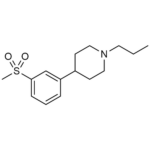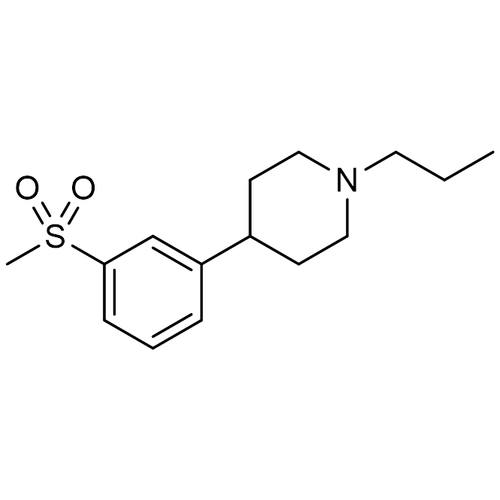| Product Name | Pridopidine |
| Description |
Neuroprotective |
| Purity | >98% (TLC); NMR (Conforms) |
| CAS No. | 346688-38-8 |
| Molecular Formula | C15H23NO2S |
| Molecular Weight | 281.4 |
| Field of Use | Not for use in humans. Not for use in diagnostics or therapeutics. For in vitro research use only. |
Properties
| Storage Temperature | -20ºC |
| Shipping Temperature | Shipped Ambient |
| Product Type | Inhibitor |
| Solubility | May be dissolved in DMSO (10 mg/ml) |
| Source | Synthetic |
| Appearance | White powder |
| SMILES | CCCN1CCC(C2=CC(S(C)(=O)=O)=CC=C2)CC1 |
| InChI | 1S/C15H23NO2S/c1-3-9-16-10-7-13(8-11-16)14-5-4-6-15(12-14)19(2,17)18/h4-6,12-13H,3,7-11H2,1-2H3 |
| InChIKey | YGKUEOZJFIXDGI-UHFFFAOYSA-N |
| Safety Phrases |
Classification: Warning GHS Hazard Statements,: H302, H361d Precautionary Statement Codes,: P203, P264, P270, P280, P301+P317, P318, P330, P405, and P501 |
| Cite This Product | Pridopidine (StressMarq Biosciences Inc., Victoria BC CANADA, Catalog # SIH-626) |
Biological Description
| Alternative Names | 4-(3-(Methylsulfonyl)phenyl)-1-propylpiperidine; ACR16 |
| Research Areas | ALS Disease, Neurodegeneration, Neuroscience |
| PubChem ID | 9795739 |
| Scientific Background | Potential treatment for Huntington’s disease, Parkinson’s disease, and schizophrenia (1,2). Able to reverse both hypo- and hyperdopaminergia depending on local dopamine concentrations without inducing catalepsy. This was originally attributed to functional dopamine D2 antagonism with fast on/off kinetics (“dopamine stabilizer”) (3). More recent studies have attributed pridopidine’s effects to its being a more potent sigma-1 ligand than a D2 ligand (4,5). Displays neuroprotective/restorative effects (6,7) and ameliorates central features of amyotrophic lateral sclerosis pathology (8) in a sigma-1-mediated manner. |
| References |
1. F Pettersson et al. 2010 J. Med. Chem. 53:2510. 2. S Natesan et al. 2006 J. Pharmacol. Exp. Ther. 318:810. 3. T Dyhring et al. 2010 Eur. J. Pharmacol. 628:19. 4. K Sahlholm et al. 2015 Psychopharmacology (Berl) 232:3443. 5. K Sahlholm et al. 2013 Mol. Psychiatry 18:12. 6. V Francardo et al. 2019 Neurotherapeutics 16:465. 7. D Ryskamp et al. 2017 Neurobiol. Dis. 7 97(Pt A):46. 8. A Ionescu et al. 2019 Cell Death Dis. 10:210. |



Reviews
There are no reviews yet.